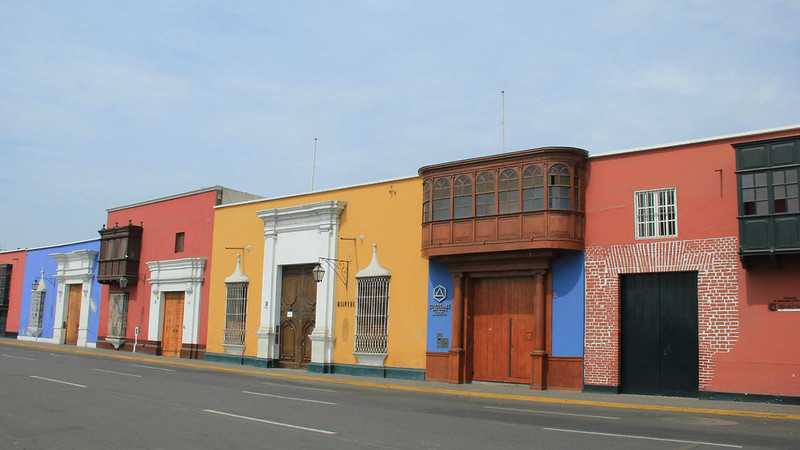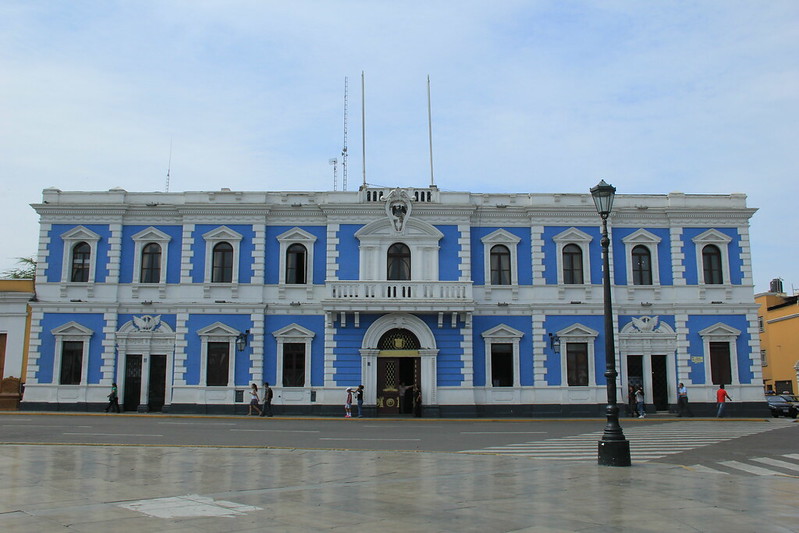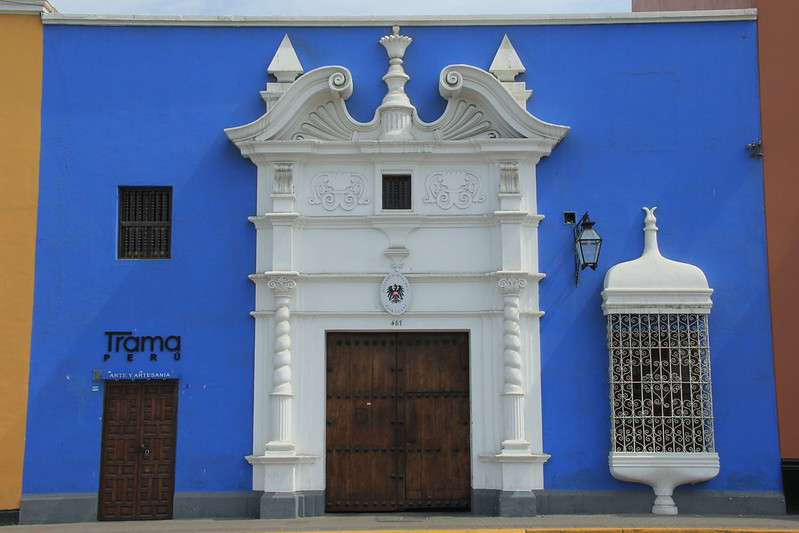Up to this point we’d avoided overnight buses, on which – according to Lonely Planet – “muggings and assaults are more likely to occur.” They’d also warned us that “fatal [bus] accidents are not unusual in Peru”, but as there is no rail network in Peru and airports in only 17 locations throughout the country (aside from the fact that air travel is pretty expensive by comparison), we didn’t have a lot of choice as to whether we travelled by bus in the first place.
However, after some reassuring words from Marv and Sara in Máncora (they’d been travelling in Peru for 7 months, and taken a lot of buses – most of which had been overnight), and armed with the prior knowledge that the scenery along Peru’s coastline is pretty unspectacular to look at, we decided to bite the bullet and book a ticket on an El Dorado overnight bus bound for Trujillo.
Ok, so I did take a couple of sleeping pills at the start of the journey (partly in order to (hopefully) achieve what they promised (sleep) and partly to subdue my growing concern that the later – or earlier – it got, the more tired the driver would become. A tired driver = a driver who is not safely in charge of his vehicle, and therefore the lives of his 60+ passengers.
I assume I must have managed to grab at least a few hours of sleep, because the 10-hour journey seemed to fly by. Having front row seats (and therefore the benefit of ample space in which to spread out and stretch your legs) definitely helped. However I have since discovered that these are the worst seats to choose in case of an accident (I did wonder why they were not snapped up before any of the others), so we sacrificed comfort in favour of safety on all our future bus journeys.
We arrived into Trujillo at 9am, and were dropped of at Munay Wasi, the hostel we’d booked here for a couple of nights. Having completed the difficult check-in process with an incredibly scatty old lady who had to ask twice if we’d actually given her any money, we met Linda and Peter (the German couple who’d been part of our final – and most memorable – night out in Chachapoyas). Ok, I didn’t think we’d been travelling particularly quickly – bearing in mind we’d spent 6 nights in Máncora – but when we discovered that they’d come to Trujillo from Chachapoyas and that we’d stopped at Leymebamba, Cajamarca, Chiclayo, and Máncora in between, we began to reconsider this fact. Oddly enough they were checking out of the room we were checking into.
Despite her rather eccentric bout of scattiness earlier on, and the fact that we ended up with a double room with shared bathroom instead of a twin private, the lady who owns Munay Wasi was kind enough to offer us breakfast whilst we waited for our room to be prepared (bearing in mind we’re only ‘strictly’ entitled to it on the morning after we’ve stayed for a paid night at the hostel).
Having showered and consumed multiple cups of coffee in an attempt to make us feel a little more awake, we headed out to discover for ourselves whether Trujillo really is as attractive and colourful as it appears in all the photos.
And do you know what? It really is.
Founded by Francisco Pizarro in 1534, Trujillo is the location of the first Spanish colony in Peru. Despite its history of left wing politics and rebellion – the city was also the first to declare its independence from Spain in 1820 – Peru’s northern capital has in more recent years only seen the occasional street protest.
It’s more famous nowadays for its many churches, lavish colonial architecture, and colourful mansions, and is home to a lively arts community, having sponsored numerous national and international cultural events.
Although Trujillo’s buildings are beautiful to admire from the outside, make sure you time your visit on a week day so that you can also appreciate the inside of Trujillo’s colonial houses, most of which are in good repair and are still in use today.
Two of our favourites were Casa de Urquiaga, the huge blue and white building on the south-eastern side of the Plaza de Armas, and Palacio Iturregui, a couple of blocks north-east of the Plaza de Armas.
Casa de Urquiaga has been owned and maintained by Banco Central del Reserva del Peru since 1972. Although originally built in 1604, this colonial mansion was completely destroyed by an earthquake in 1619, and has been rebuilt and preserved since.
19th century mansion Palacio Iturregui is an ornate, neoclassical-style building which is now used as a private social club. For this reason, although you can wander around the internal courtyard at any time of day, and its completely free, visiting the ornate rooms is restricted.
We also loved wandering around Trujillo’s elegant, Spanish-style streets and photographing the large colonial windows with wonderfully ornate wrought iron grillwork.
Many of the colonial houses have also been converted into cafes and restaurants, so when we needed a coffee break or something to eat, we could admire the beautiful interiors of the buildings from the comfort of our own seats.
Although Casona Deza (Independencia 630) is extremely over-priced, what you pay for are the incredible surroundings. This building has character, and is a photographer’s dream.
La Llave (yes, it’s one of those annoying Spanish nouns that looks like it should be masculine and it’s not) is located in the Plaza de Armas itself (Orbegoso 471), but is surprisingly much more reasonably priced.
In case you hadn’t guessed by the photographs, ‘llave’ means ‘key’, and the cafe is filled with old keys, some of incredibly ornate and unusual designs, that are hung on the walls or incorporated into the artwork. They also serve Cusqueña Roja, which is a huge bonus in my book!
Trujillo is a great place to base yourself to explore the nearby ruins of Chan Chan (the largest pre-Columbian city in the Americas), and is also a lovely city in which to stop for a couple of days in order to break up the long journey from the north of Peru to Lima (or vice versa).
Hopefully my photographs will have shown you that, even when the sun is not shining, Trujillo’s grand and colourful colonial buildings are enough to brighten up any day. But if you don’t believe me, then why don’t you come and see for yourself? 😉
Have you visited anywhere quite like Trujillo?
If you like this article, please follow along on Facebook or Twitter
This is part of the #SundayTraveler link up, the spot to be to get the lowdown on all things travel.


























11 Comments
Nice! I might go to Peru next year, so it is good to know about Trujillo 🙂 Thanks for the information about the night buses
Wow those pictures are awesome! I always have concerns with buses here in Latin America, too… but I convince myself: no risk no fun >.< haha!
Thanks San 🙂 Yeah, this is true! I took the bus between Leimebamba and Cajamarca, north east of Trujillo, and according to Lonely Planet it’s one of the most frightening, but spectacular road journeys in Peru. They weren’t wrong!
I love all the bright colors of the buildings.
Beautiful, aren’t they Heather? 🙂
Beautiful photos. We spent a few days in Lima earlier this year and found the central area just lovely. I think the crowd who just visit Machu Picchu and leave do themselves a disservice.
I totally agree! Yes I did enjoy hiking the Inca Trail to Machu Picchu immensely, but there is so much more to Peru. I spent 3 months in the country, and I still feel like I missed parts I would have liked to have visited, and didn’t spend long enough in other destinations. It’s a beautiful country 🙂
Wow! I love the colours of the buildings! I’ve been in some villages that have had brightly coloured buildings (Cluj in Romania comes to mind), but non of them have been this well maintained.
Yes, I was amazed at just how well-maintained the buildings were – both inside and out. It’s definitely a photographer’s paradise. The skies were a little cloudy for much of our stay, so I can only imagine how much more vibrant it would all look in the sunshine 🙂
I traveled by bus in Chile, and it was beautiful but terrifying. I had to stop looking out the window because the memorials for crash sites were so frequent that they were starting to freak me out.
I know exactly how you felt! Unfortunately bus travel in South America does not have the best reputation in the world, which was enough in itself to freak me out…